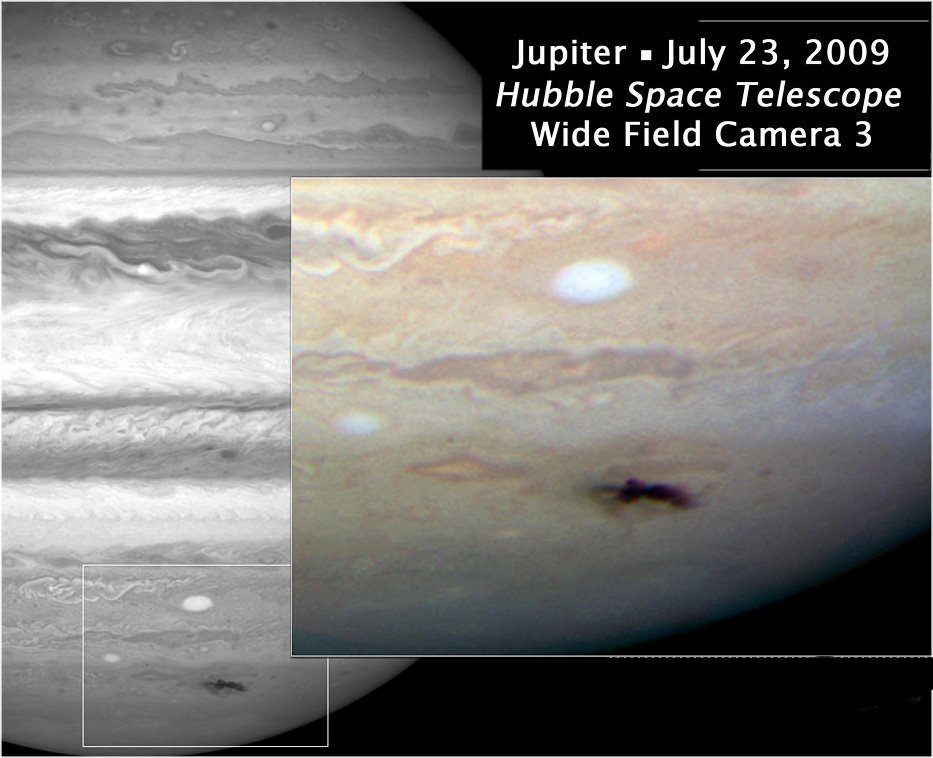[/caption]
The Hubble Space Telescope was undergoing a thorough checkout of all its systems following the recent servicing mission, but scientists decided to drop everything and interrupt the observatory’s checkout and calibration to take an image of what every other telescope has by trying to view: the impact site on Jupiter. But Hubble does it better than anyone. This image, taken just yesterday (July 23) shows the black spot on the giant planet — created a small comet or asteroid — is expanding.
“Because we believe this magnitude of impact is rare, we are very fortunate to see it with Hubble,” said Amy Simon-Miller of NASA’s Goddard Space Flight Center in Greenbelt, Md. “Details seen in the Hubble view shows a lumpiness to the debris plume caused by turbulence in Jupiter’s atmosphere.”
The new Hubble images also confirm that the May servicing visit by space shuttle astronauts was a big success.
The Jupiter impact has been a sensation ever since Australian amateur astronomer Anthony Wesley imaged a black spot on the planet on July 19. , The only other time such a feature has been seen on Jupiter was 15 years ago after the collision of fragments from comet Shoemaker-Levy 9.
For the past several days, Earth-based telescopes have been trained on Jupiter. To capture the unfolding drama 360 million miles away, Matt Mountain, director of the Space Telescope Science Institute in Baltimore, gave observation time to a team of astronomers led by Heidi Hammel of the Space Science Institute in Boulder, Colo.
“Hubble’s truly exquisite imaging capability has revealed an astonishing wealth of detail in the impact site,” Hammel said. “By combining these images with our ground-based data at other wavelengths, our Hubble data will allow a comprehensive understanding of exactly what is happening to the impact debris.”
Simon-Miller estimated the diameter of the impacting object was the size of several football fields. The force of the explosion on Jupiter was thousands of times more powerful than the suspected comet or asteroid that exploded over the Siberian Tunguska River Valley in June 1908.
The image was taken with the Wide Field Camera 3. The new camera, installed by the astronauts aboard space shuttle Atlantis in May, is not yet fully calibrated. While it is possible to obtain celestial images, the camera’s full power has yet to be seen.
“This is just one example of what Hubble’s new, state-of-the-art camera can do, thanks to the STS-125 astronauts and the entire Hubble team,” said Ed Weiler, associate administrator of NASA’s Science Mission Directorate in Washington. “However, the best is yet to come.”
Source: NASA


I dunno about you guys, but joke about 2001, A Space Odyssey, are more than a little worn out at this stage…. 🙂
Seriously though, great picture, and it’s great to see the refurbished HST being put to work. (FYI: the original date for putting Hubble back to work was September, so kudos to the imaging team for getting on to this so quickly.
I dunno about you guys, but that sure looks like the place where the monoliths are spawning from. ALL THESE PLANETS ARE YOURS EXCEPT EUROPA.
I’ve heard so many size estimates, to now only a couple football fields. I guess this shows how much damage a little ole space rock can do
Hey has anyone mentioned yet that this looks a lot like the scene described in 2001, A Space Odyssey?
Just kidding, though I am serious when saying I am very happy about this for two reasons: Cool Jupiter pictures and NEW HUBBLE TELESCOPE IMAGES! Woot!
On a related note, has anyone here had to reassure any friends/family members that the Earth is safe even though Jupiter appears to be being pummeled at the moment? One of my family was concerned that the Earth was going to be next! =P
They’ve been trying to turn Jupiter on since 1994, but obviously their matches are wet.
– My name is Hubble, ST Hubble.
[Yeah, I got tired of the 2001 world set two articles ago. _And_ the old “I told you size matters” tube jokes.]
Sorry to be picky guys but the scene you’re refering to comes from the sequel 2010 NOT 2001.
Cool picture, am glad to see Hubble is working well again.
That’s right, Jupiter didn’t turn into a star until 2010………next year…….strange.
Great to see Hubble sending us some love. I want more!